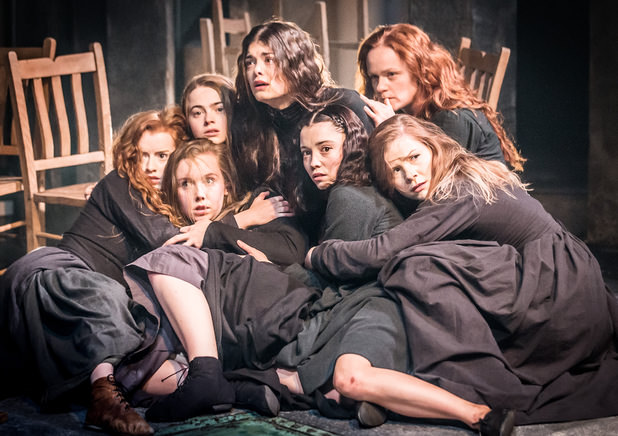In his autobiography, Timebends, playwright Arthur Miller notes that The Crucible, his 1953 play about the Salem witch trials, seems to revive in places where tyranny has either recently toppled or is about to take over. What tyranny could be closing—or losing—its grip on London’s throat these days, given the fact that a production of The Crucible has just triumphed through the ritual Press Night on July 3 at the Old Vic Theatre?
The first reviewer to weigh in was Quentin Letts of that tabloid of tabloids, the Daily Mail, under the headline “The Incredible Hunk Casts his Spell”:
There were more women than men in the Old Vic audience for The Crucible. They were there to gawp at film star Richard Armitage, who takes the central role of John Proctor, the farmer whose one marital infidelity leads to a downfall of alleged devilry and witchcraft.
Arthur Miller’s tragedy of witch-hunting in Salem, Massachusetts, in 1692 was written as a metaphor for the anti-communist excesses of Fifties America.
It is a necessarily claustrophobic story, never easy to watch. You do not go to The Crucible for enjoyment—certainly not here, where director Yael Farber’s time-keeping has run out of control.
At Wednesday’s preview we escaped just before 11pm. Long-winded Miss Farber obviously has little regard for theatregoers who catch trains to the suburbs.
The glacial pace of her direction may create an oppressive atmosphere but it goes far beyond self-indulgence.
Evidently, a large female spectatorship by definition diminishes the importance of the performance, just as female readership is still thought, in many quarters, to diminish the importance of books more than a generation after the apogee of Mailer, Bellow, Roth, and Updike (consider the last of these writers’ irksome insistence on calling women’s sitting bones “haunches”)—or their Britannic counterparts, Amis (Kingsley) and Fleming (Ian). Yaël Farber, The Crucible’s director, is guilty, for her part, not only of that feminine specialty, self-indulgence (so often termed “artistic license” in the hands of male counterparts, beginning with Paolo Veronese when he appeared before the Venetian Inquisition in 1573 in an unsuccessful attempt to defend the presence of two drunken Germans and a dog in a painting of The Last Supper), but indeed of elitist self-indulgence, keeping the people from their commuter trains in heedless pursuit of her artistic vision.
That vision includes two opening vignettes that add to the production’s length but also set a mood: the lights come up on a pile of shoes, the actors file in silently and put them on, and then file out again. Then the barefoot Caribbean slave Tituba makes a slow circuit around the performance space, carrying a steaming kettle. Farber believes that theater is still a ritual, just as in ancient Greece, and these two moments are eminently classical: first the actors don their tragic buskins, the special dancing slippers they wear for the performance (Greek actors would also have put on their masks), and the orchestra space is consecrated to the god Dionysus. Here Tituba’s circuit marks off that same circular dancing floor, but it also evokes the initial incident that sparked the witchcraft trials, at least in Miller’s telling of them: a group of Salem girls were dancing in the woods with Tituba and telling fortunes when the local minister caught them at it. There is witchcraft afoot in this Salem, the literal witchcraft of Tituba and the girls, and the timeless magic of theater.
The Daily Mail’s Letts, however, has a more sober, manly view of the proceedings. No gawping here:
But what a hunk Mr Armitage is. Proctor’s first entrance is greatly powered by this actor’s physical magnificence. He smoulders more than any campfire and projects a palpable earnestness which sits well with his character.
Another critic, Nick Clark of The Independent, tweeted with greater self-awareness:
Richard Armitage was excellent as John Proctor. I imagine, like me, the other males in the audience suddenly felt very Beta.
Mr. Letts certainly sounds like a man afflicted with feelings of betadom when he carps:
Talking of voices, Mr Armitage’s is unexpectedly weak, echoey, croaky. It is not the voice you expect from such a beefcake. He also has a habit of raising his gaze towards the top of his skull, as though searching for crumbs in his eyebrows.
In this implicit plea for readers to love him for his witty phrasing, the critic betrays what is surely resentment as much as acuity; Armitage finds distinct voices for the characters he plays, and for John Proctor he has picked a gruff, growling bear, as raw at the edges as Proctor’s view of things. Resentment, of course, is the fuel that drives Miller’s complex play. Three of the tragic heroes caught in the toils of Miller’s intricate plot are pulled to their deaths by it: frail, sensible Rebecca Nurse and the two Titans, Giles Corey and John Proctor, who look on appalled as their neighbors’ resentment is implausibly but implacably transformed into accusations of witchcraft. These great oaks of men ultimately fall to the axe of pusillanimity.
Advertisement
The Crucible endures as drama because of the biting contrasts it draws between sanity and insanity, rationality and irrationality, and in the play these qualities are shared by men and women in equal measure. Miller pins his plot on Abigail Williams, the teenaged servant girl who resorts to witchcraft after she has been bedded by Proctor and dismissed by his jealous wife. Abigail (played by a fierce Samantha Colley) is a conniving, troubling figure, traumatized by her parents’ violent death and the harsh realities, social and sexual, of life as a servant in Puritan Massachusetts, but she is not the play’s sole villain. A band of screaming adolescent girls could not have driven the Salem trials forward without the solemn collusion of magistrates and ministers, the very embodiment of masculine probity (the word that falls like a blade from the lips of Deputy Governor Thomas Danforth in Miller’s script, and is barked out with chilling precision by Jack Ellis in a bravura performance).
Supreme sanity, in fact, resides in Miller’s female characters: Rebecca Nurse and, in a heartbreaking transformation, John Proctor’s plain, insecure wife Elizabeth (played with quiet grace by Anna Madely), whose sense of physical (hence sexual) inadequacy mirrored Miller’s own guilt-ridden preoccupation with Marilyn Monroe, whom he had met in Los Angeles shortly before beginning to write The Crucible. John Proctor “has found his own goodness” by the time he marches off to the gallows, but it is a goodness felt rather than reasoned. As his wife tells him, he is “a good man, only somewhat bewildered.” It is one of the signal strengths of Yaël Farber’s production (and a strength of Armitage himself in his portrayal of Proctor) that this staging of The Crucible is the work of a seamless ensemble, a collaborative enterprise that militates rather strongly against the idea of any one person’s self-indulgence, even if they have put on their acting boots at the beginning. Footballers gather for a huddle too before the game.
The significant presence of women theatregoers at The Crucible really means that a large number of women in and around London lead independent lives and exert independent judgment, to conclude, inter alia, that Richard Armitage is an actor worth watching for his acting no less than his physique, and that Yaël Farber is a director to reckon with. The production was advertised in advance as “visceral,” for Farber is famous for her physical demands on actors; and indeed this cast runs, leaps, screams, shouts, grapples, and throws fits with remarkable ferocity, apparently without injuring anyone in the process. That, too, could be self-indulgence, but what are actors’ bodies for if not to be used to the full to tell their tales?
The presence of a woman director at the Old Vic means that women are running the business of theater more actively than they may have in the past. It is not hard to search for one toppling tyranny in Britain, a tyranny that continues to threaten elsewhere around the globe: the tyranny of male over female. Arthur Miller can rest assured that The Crucible is once again speaking at a crisis point in society.
Yaël Farber’s production of Arthur Miller’s The Crucible is playing at The Old Vic in London through September 13.




